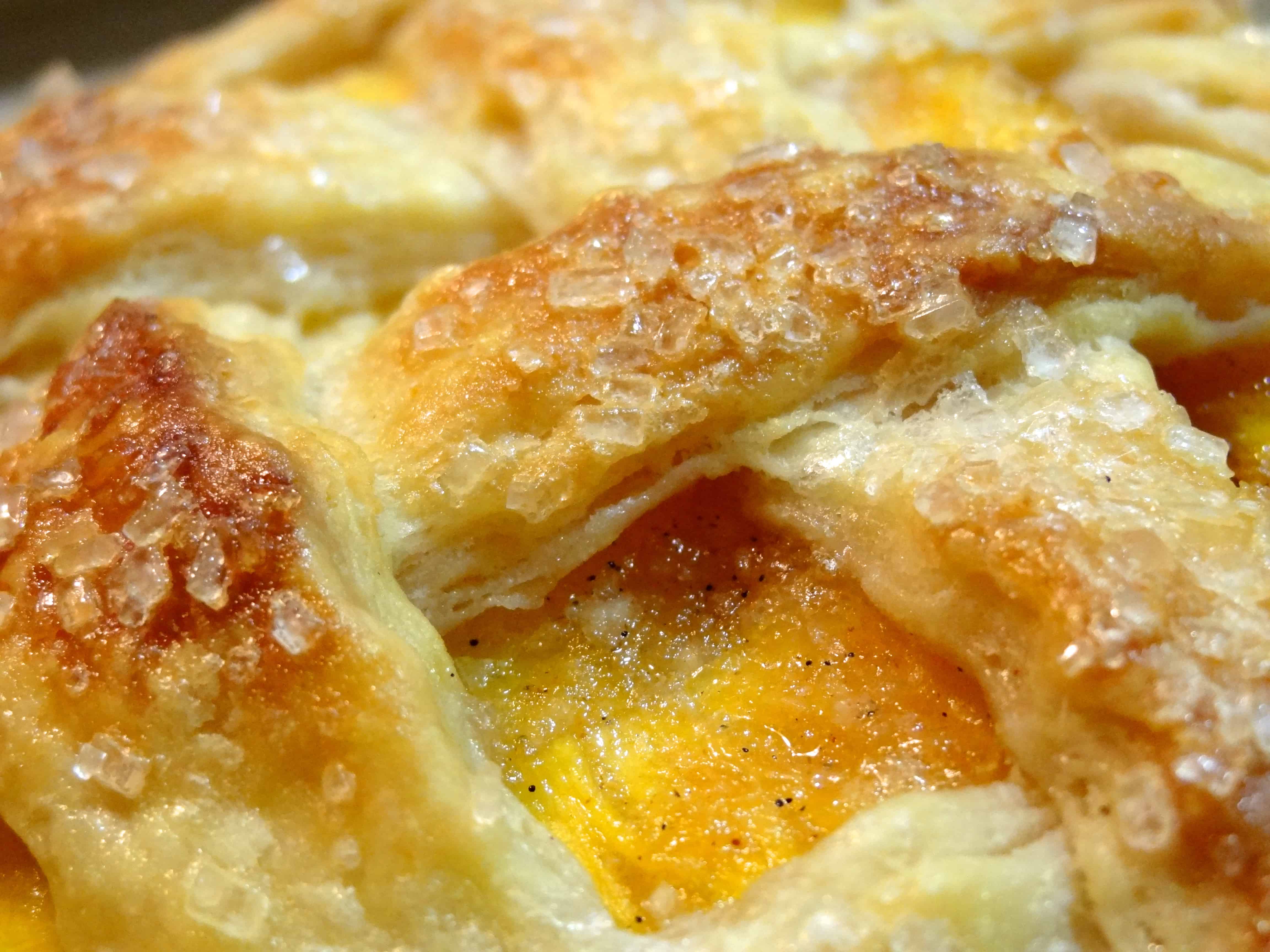
I wish I had a charming, nostalgic story to tell you about pie; something like, ‘I used to watch hungrily over the edge of the countertop when I was a little girl as my grandmother lovingly crimped her pie dough edges while humming’… but I don’t. I didn’t eat much pie growing up, and it’s a fairly new addition to my baking repertoire. In fact, I was a bit scared of pie dough until recently, but we’ve become friends. 🙂
I’ve been a little obsessed with pies this summer. To be more specific, Smitten Kitchen pies. Deb Perelman’s flawless, absurdly easy, and amazingly flaky pie crust has inspired me to explore pie-making with the wonderful fruits of summer available at the farmers’ market right now. I made her Strawberry-Rhubarb Pie a while back, which I loved, and I decided I wanted to make something with a pretty lattice top the next time. I’m not a huge fan of blueberry or cherry pie, but peach— YES, that’s the one. I searched around for peach pie recipes, and the one that appealed to me the most was Smitten Kitchen’s, again. However, I wanted to put a little twist on it. I fully respect her view that peach pie need not be altered in any way, but I thought that adding vanilla bean seeds would be divine– vanilla gives everything it touches a wonderful warmth and depth of flavor, and this was no exception. So yes, I think vanilla improves even peach pie, that classic dessert of summer. Basically, it makes the world a better place in all regards.
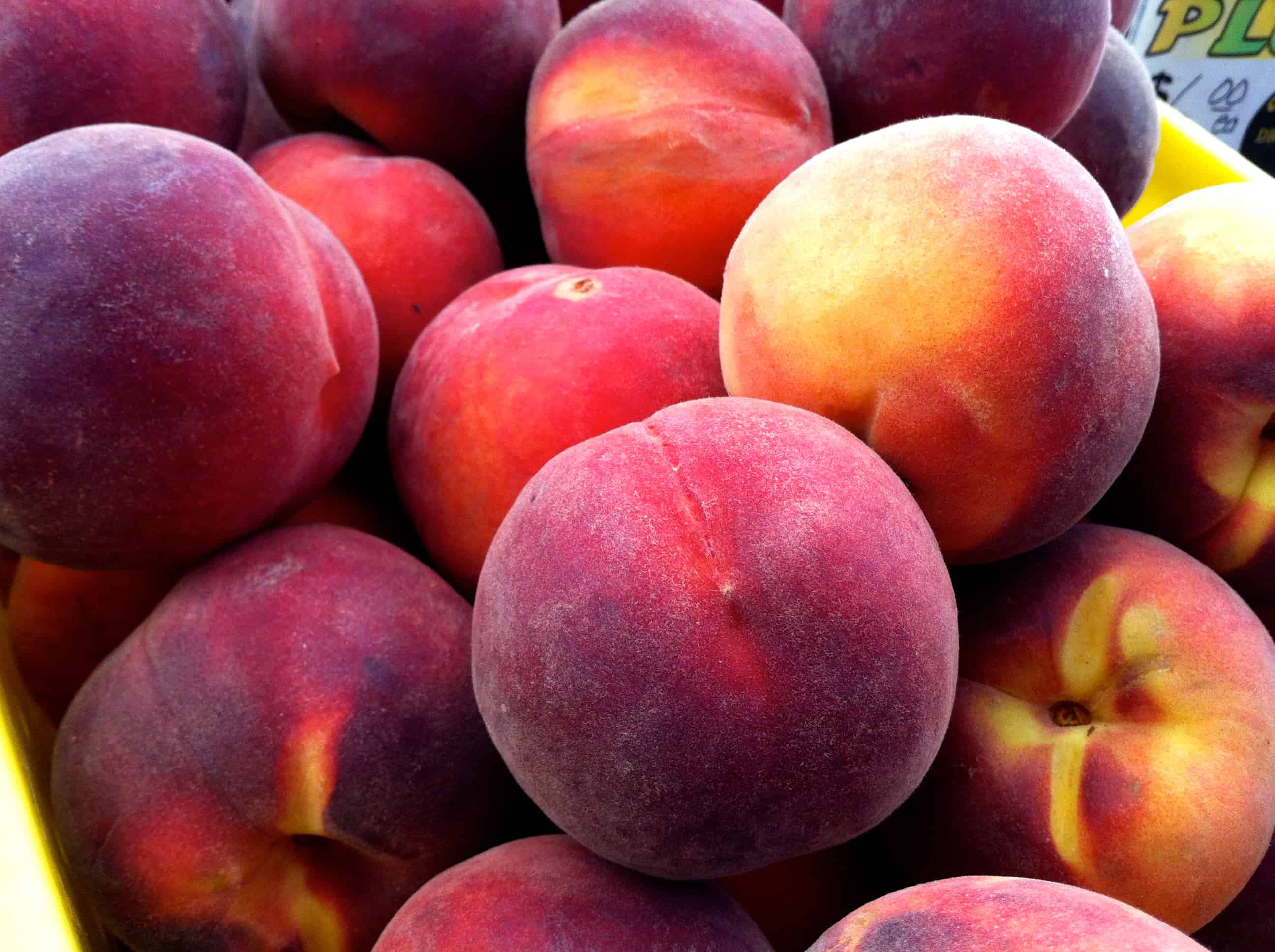
Pie makes people feel better, no matter what. The closest I can come to a pie story is that this particular pie was instrumental to my livelihood after ankle surgery this summer. Healing power? Possibly. Comfort? Definitely. I knew I had a 6-week recovery ahead of me, with crutches and a walking boot– I’ve done this song and dance many times before. In the days leading up to my surgery date, I found myself rushing around to clean up the apartment, cook some healthy meals to stick in the freezer, and run errands before my mobility would be squashed for several weeks. I felt like I was nesting in preparation for a baby or something… except without a cute, new little person. As I said, I’ve had pie on the brain, and I had just bought 4 pounds of peaches– I was determined to make this pie before the great summer darkness set in. It didn’t look promising, as things were quite busy; those peaches came dangerously close to a tragic, mushy demise, but plans changed the day before surgery, so I jumped at the opportunity to make my pie! I thought about calling it “Surgery Pie” or “Ankle Pie”, but… that would be gross.
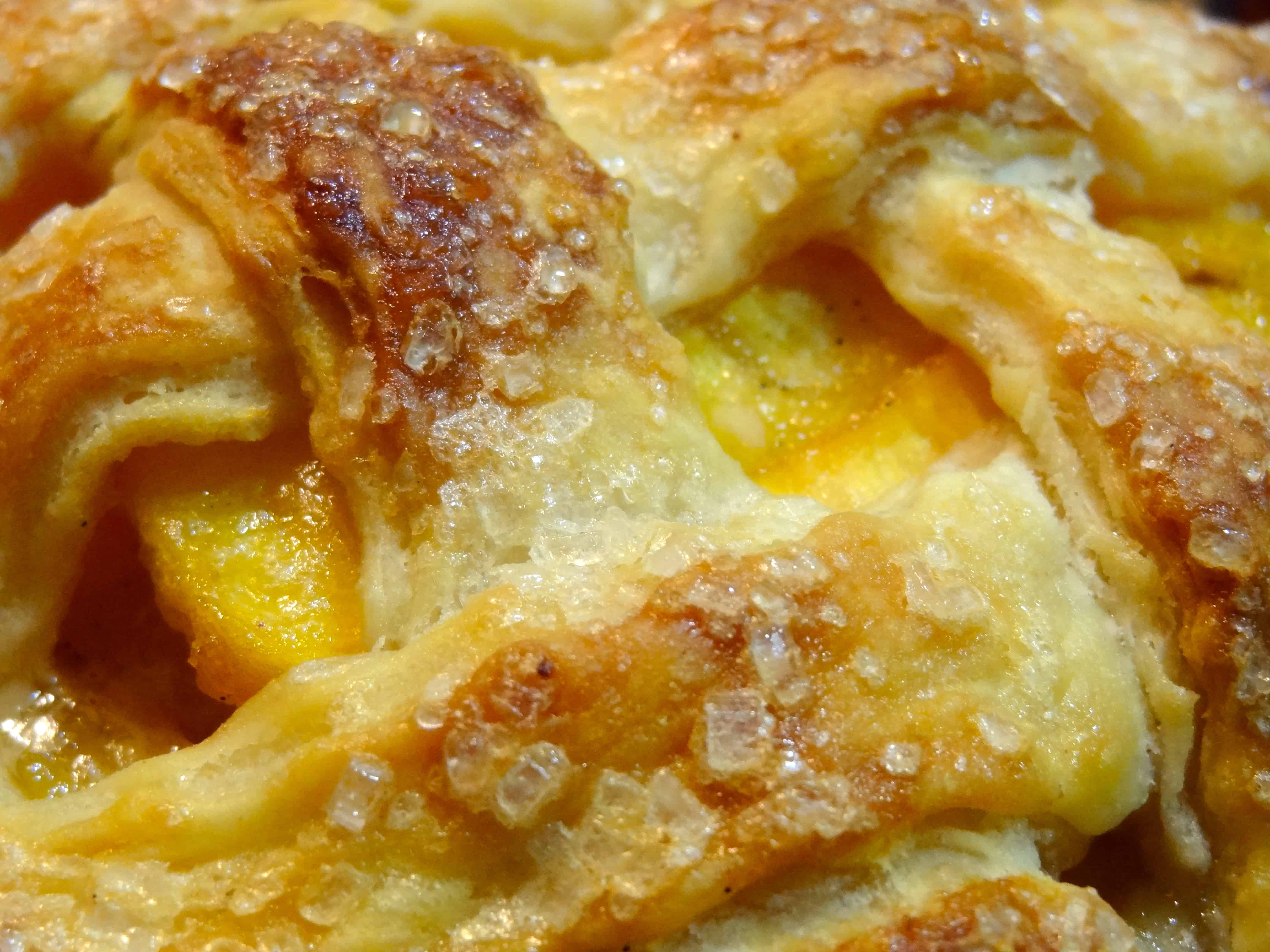
Although it meant making a big mess in the kitchen (countering my clean-up efforts), I am SO glad I made this pie. It’s better once it has cooled, because the filling firms up, so I didn’t dig into it until after I was laying on the couch with my leg propped on pillows the next evening. (Why yes, I was quite proud of my self-restraint, thankyouverymuch.) I was so grateful to have had this perfect, summery pie in the days immediately following surgery; the flake-tastic crust, tender, sweet peaches, and wisp of vanilla were truly dreamy. And I’m pretty sure it wasn’t just a side effect of the narcotics. As cabin fever set in, along with the reality of being mostly helpless for a while and the sadness of not being able to bake for a few weeks (it’s hard to say which was worse), this pie was the highlight of my first few days spent on the couch, and for that, I am grateful. Oh look, I guess that’s kind of a pie story after all, even though there are no grandmothers involved. 🙂
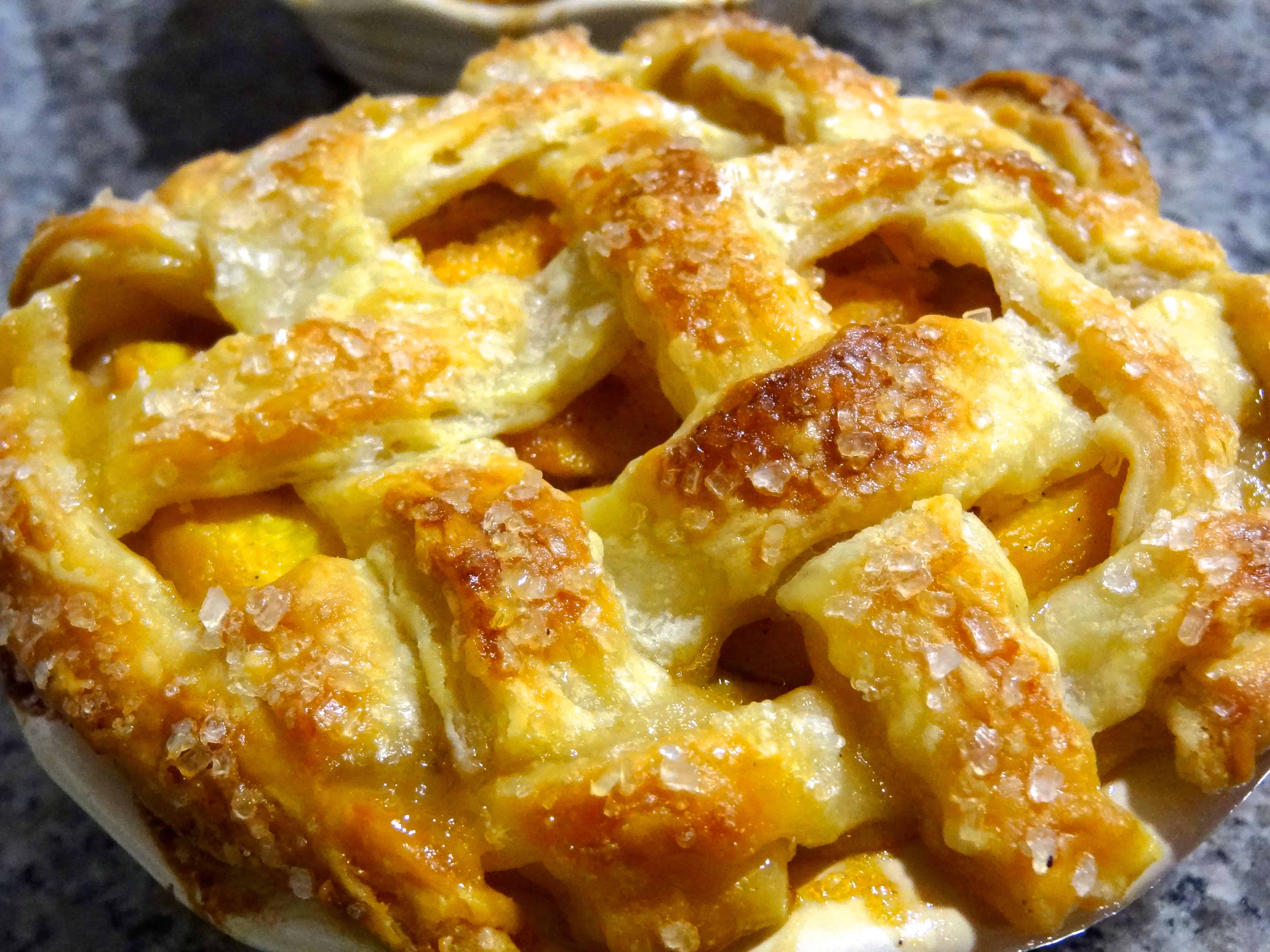
This is one of the best pies I’ve ever had, and certainly the best one I’ve made myself. I can’t say enough about the crust– it is perfectly flaky and crisp, easy to work with (my rolling issues notwithstanding), does not get soggy, and its buttery flavor is just SUPER. The peach filling is pretty brilliant too– just the right amount of sweetness, and the peaches are bursting with the flavor of summer! I love that they still had a little bite to them– no sad, orange mush here. (Increase the baking time for a softer filling if you wish, though I think it’s nice to have a bit of texture.) I was so completely thrilled with this pie in every way– an instant summer classic in my kitchen for sure! 🙂
A few notes about ingredients:
- Sugar: This recipe calls for only ½ cup sugar, less than the typical peach pie. It’s split evenly between white and brown sugars, but you can use all of one type, or increase the sugar if you feel that the pie isn’t sweet enough. I thought the amount and proportion of sugar was perfect, allowing the natural sweetness of the peaches to shine through.
- Tapioca: To thicken the pie, this recipe uses instant tapioca (available in many supermarkets) instead of cornstarch. When I used this in the Strawberry-Rhubarb Pie, it definitely worked to thicken the filling, but there were some undissolved pearls still visible, imparting a slightly unattractive look and chewy-ish texture. Still delicious, but there’s room for improvement. In this recipe, Ms. Perelman recommends grinding the tapioca granules in a spice grinder or coffee grinder into a powder-like state, which will turn clear when cooked. I don’t have either type of grinder, and she says that food processors and blenders are not effective, so I “chopped” it by hand with a large chef’s knife. Now, it worked well enough to break down a lot of the tapioca pearls to achieve the results I wanted in the baked pie filling, but there was tapioca all over the kitchen by the time I was done, so I don’t really recommend this method. I will try it next time in my “mini-prep” processor. Bottom line, try to grind down the tapioca as best you can, but if you don’t have these tools, it’s okay to use the tapioca straight from the box. You can also substitute cornstarch or potato starch, but I can’t vouch for the results.
- Peaches: This recipe, and many peach pie recipes, calls for blanching the peaches and then immediately submerging them in ice water to remove the skins easily. I did this, and I’m not sure it’s worth the hassle. I still had to peel most of the peaches, which is an infernal and possibly even dangerous task when working with slippery, soft, semi-cooked peaches. I found it very difficult to peel and cut them, and I felt lucky not to have cut off a finger in the process! Maybe I should have boiled them a little longer to help the skins along, but next time I may peel and slice the peaches raw, then increase the baking time slightly if needed. (I’m not sure if this would affect the texture of the cooked pie, but after consulting some reliable sources, it seems that the main purpose of blanching and shocking is to remove the skins, not to cook the peaches prior to baking.)
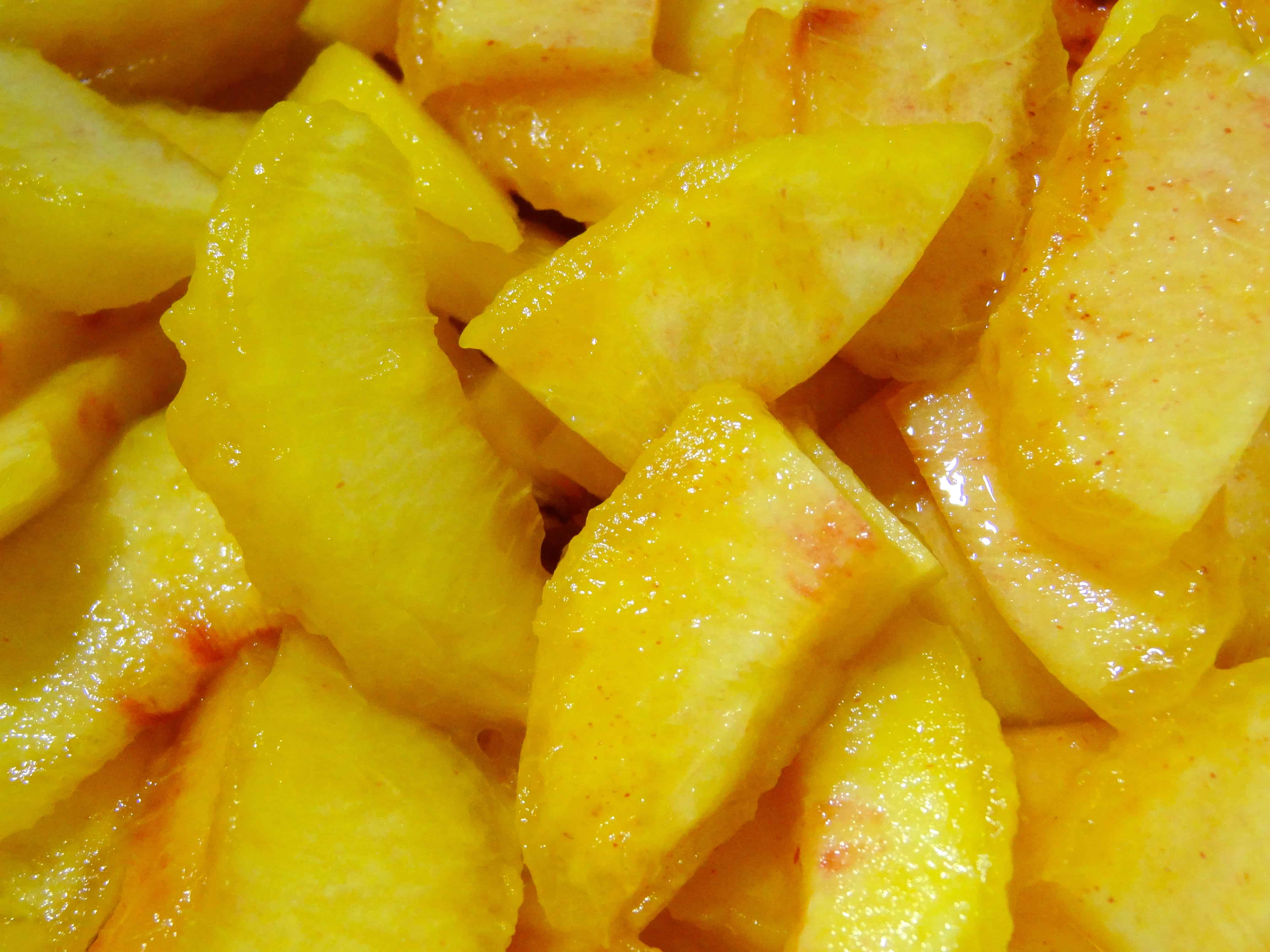
- Vanilla: Since I love vanilla so much, I decided to omit the small amount of nutmeg in the original recipe and replace it with vanilla. I wanted to lace it throughout the pie without eclipsing the peach flavor. For the filling, you can use either the seeds of 1 vanilla bean or 1 tablespoon of vanilla bean paste, which also imparts a pretty speckled appearance. I also added some vanilla on top of the pie by mixing some Heilala Pure Vanilla Bean Sugar into the course sugar topping. I stumbled upon this fabulous product at Whole Foods in Berkeley (nowhere to be seen at my local store), and I’ve been chomping at the bit to find reasons to use it– it’s golden sugar infused with vanilla extract and mixed with ground vanilla beans. (If I’m being honest, I just want to roll around in a pool of the stuff.) If you can’t find it, you can use any other homemade or store-bought vanilla sugar, or you can just use plain course sugar without the vanilla element, as written in the original recipe (though I think the extra shot of vanilla perfume is really lovely).
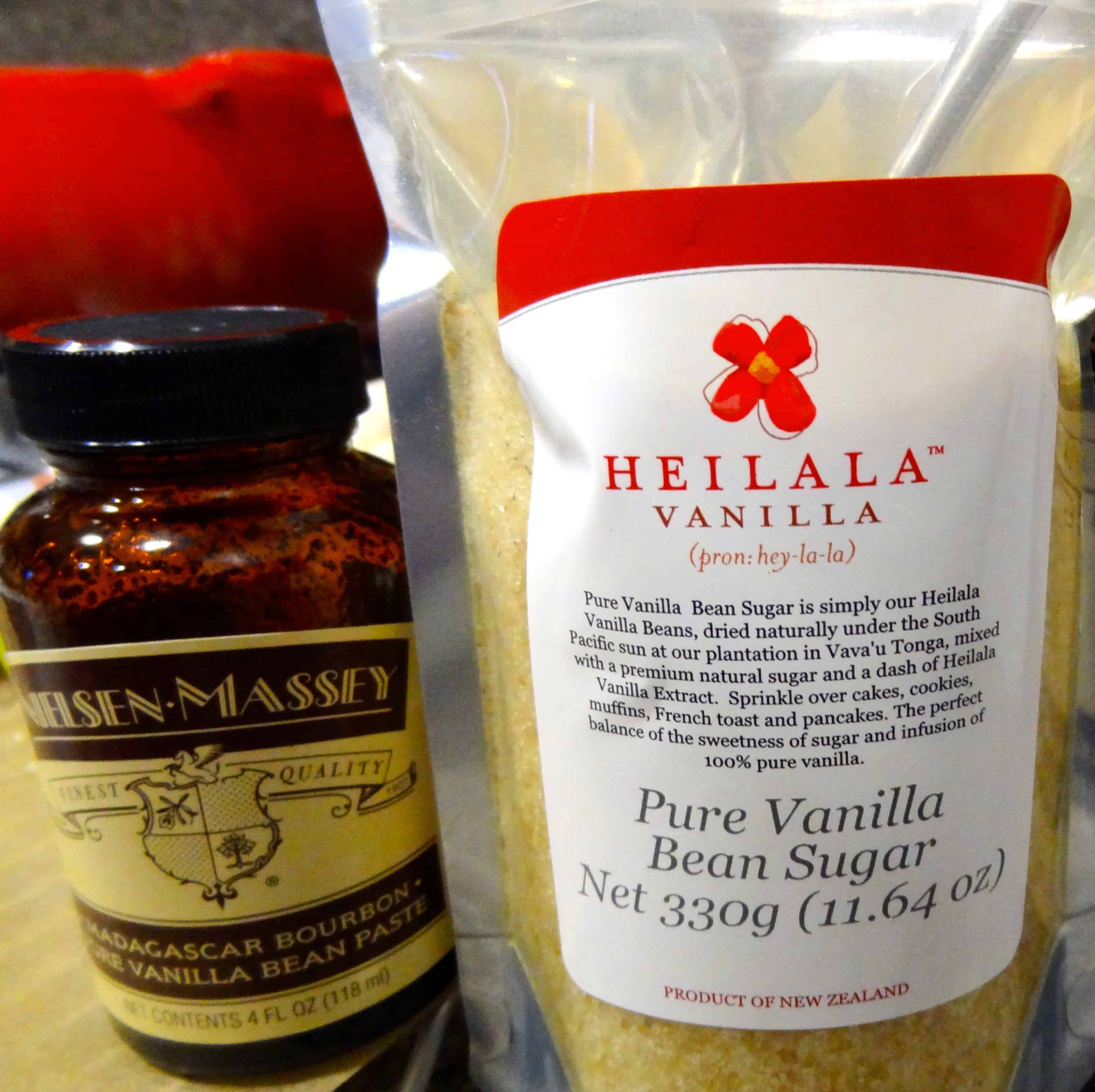
For the nitty-gritty details of working with pie dough, check out Smitten Kitchen’s Pie Crust 102, and also feel free to take a look at her tutorial about rolling and crimping your top crust. You’ll be glad you did; I definitely learned a thing or five. She also created a diagram of how to make a lattice-top pie, which is slightly different than my description below, but it will result in the same pretty pie top. All I ever needed to know about pie crust, I learned from Deb Perelman. Word.
Peach-Vanilla Bean Lattice-Top Pie
Adapted from Smitten Kitchen
Yields 1 9-inch pie or 4 mini pies
I made a full dough recipe and a ½ recipe of filling, which I used for 2 mini pies, and I froze the rest of the dough for next time. The quantities below reflect the full recipe.
For the crust:
- 1 recipe Super Flaky All-Butter Pie Dough
For the filling:
- 3 ½ pounds firm-ripe peaches (approximately 6 large, 7 medium, or 8 small)
- 1 tablespoon fresh lemon juice, from about half a lemon
- ¼ cup granulated sugar
- ¼ cup light brown sugar
- ⅛ teaspoon ground cinnamon
- 1 tablespoon vanilla bean paste, or seeds of 1 vanilla bean scraped from the pod
- ¼ teaspoon kosher salt
- 2 tablespoons instant tapioca, ground to a powder, or 3 tablespoons cornstarch or potato starch
For the topping:
- 1 tablespoon heavy cream, milk, or water
- 1 tablespoon coarse sparkling sugar or granulated sugar
- 1 teaspoon vanilla bean sugar, homemade or store-bought (optional, but highly recommended)
Have your pie dough rounds chilled and ready to use in the fridge.
To prepare the filling, bring a large saucepan of water to a boil. Make an ice bath by filling a large bowl with ice and water, and set aside. Cut an ‘x’ across the bottom of each peach. Carefully lower the peaches into the boiling water and blanch for 2 minutes. Transfer the peaches with a slotted spoon to the ice bath for 1 minute to cool.
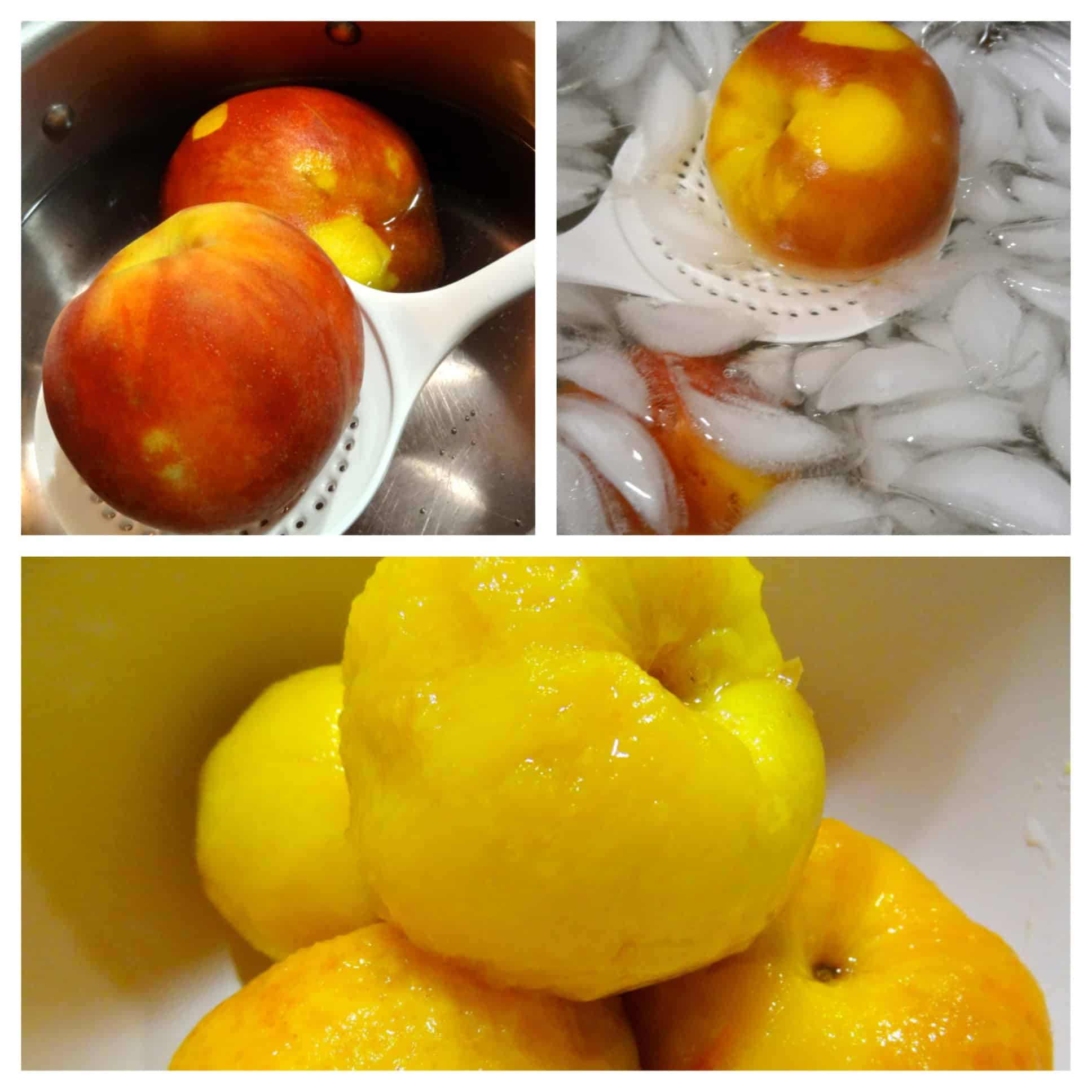
Remove the peaches to a cutting board and peel the skins. The blanching/icing process is supposed to help the skin slip right off, but this didn’t happen with most of my peaches; if your peach skins are willful like mine, use a vegetable peeler or paring knife to peel them VERY carefully.
Continuing to work carefully, cut the peaches in half and pry the flesh from the pits (which is very slippery business, let me tell you). Cut the peaches into slices approximately ⅓-inch thick– this size is not too thick, not too thin. You should have about 6 cups, and it’s fine to have a little extra. Place the peach slices in a large, non-reactive mixing bowl and toss them with the lemon juice and vanilla bean seeds/paste. In a small bowl, stir together the white and brown sugars, cinnamon, salt, and tapioca starch until they are evenly mixed. Add the dry ingredients to the peaches and gently toss everything together until they are coated evenly. Let this mixture sit out on the counter while you prepare the pie crust.
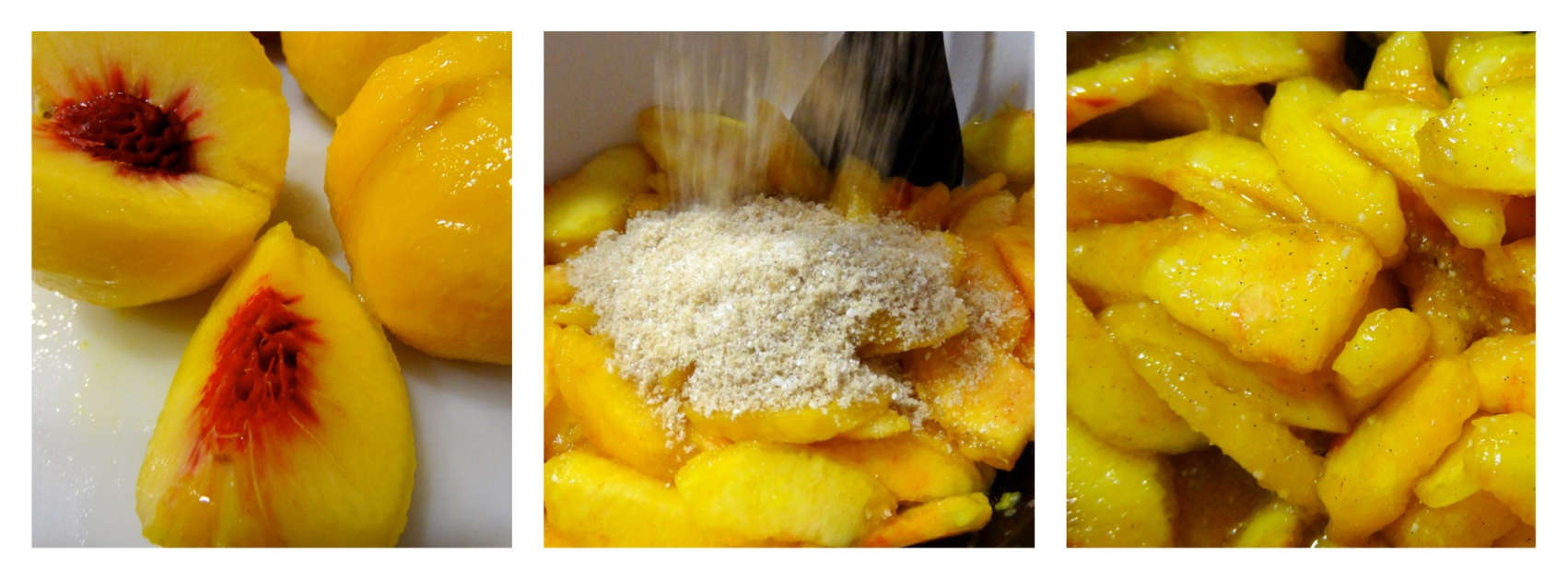
Preheat an oven to 425°F.
Generously flour your work surface and rolling pin. Unwrap your first piece of dough and sprinkle a little more flour over it. Keep the flour handy, as you will need to re-flour often to avoid sticking. Roll out the dough by starting in the center and rolling out to the edges, rotating the dough ¼ turn after every few rolls. Continue doing this until you have a 12- to 13-inch circle. (For mini pies, cut the dough round into quarters and return 3 pieces to the fridge. Roll out a 7-inch circle with the remaining piece.) Add flour as needed, and also make sure to keep your dough very cold. The latter is essential for a flaky pie crust– if there are no visible butter chunks in your dough when the pie goes in the oven, you will not end up with those lovely, flaky layers. If your dough warms up while you’re working with it, transfer it to the freezer on a cookie sheet for a few minutes to firm up.
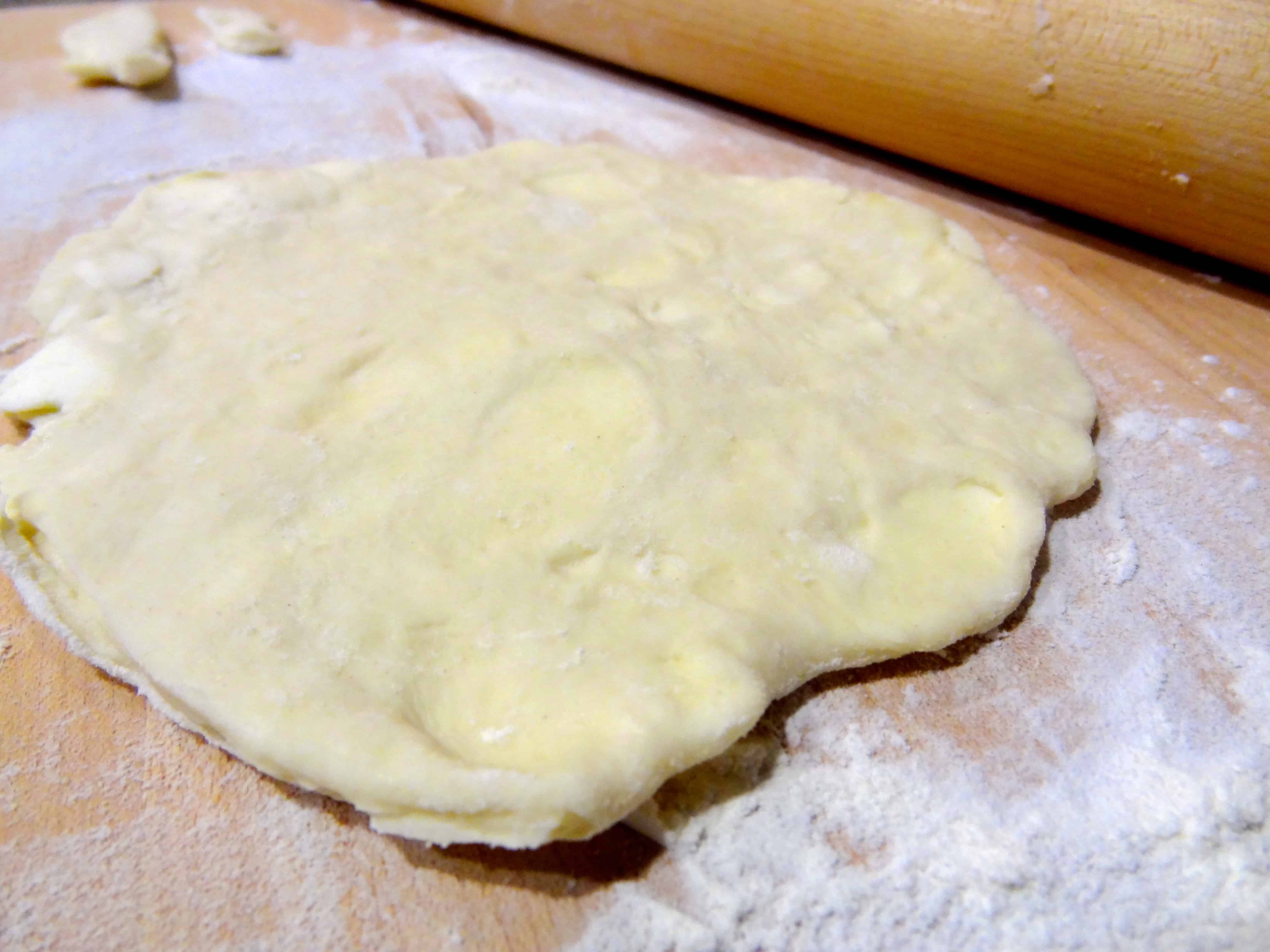
Once you’ve rolled out your dough, carefully transfer it to a 9-inch pie dish (or 4-inch mini dish); an easy way to do this is to fold the dough circle loosely into quarters (no creases), set it into the pie plate, and unfold it, centering the dough evenly. Lightly press the dough into the bottom and up the sides of the pan, then trim the overhang to 1 inch. (My photo is not a good example of this… My dough rolling still needs a lot of practice.)
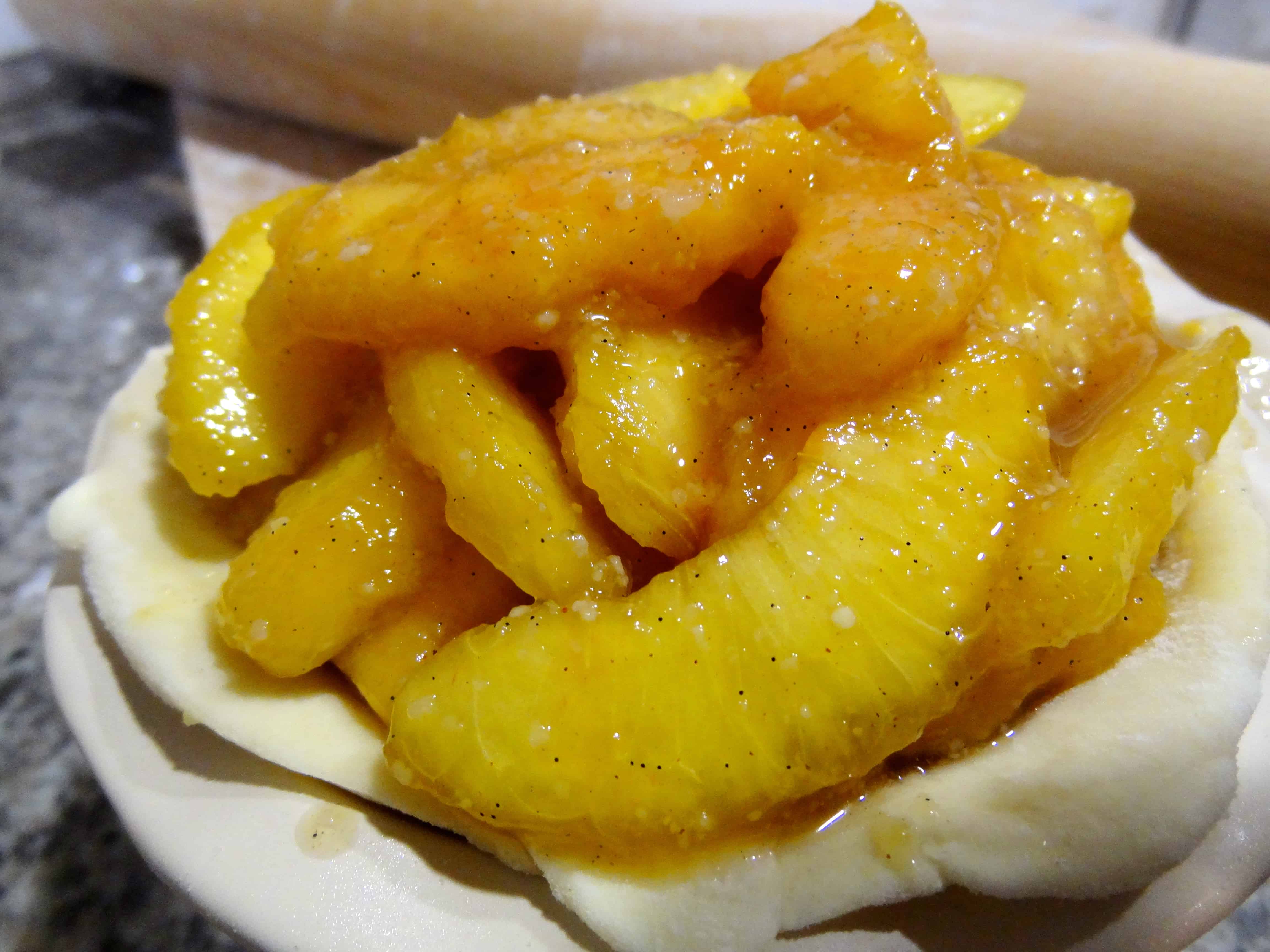
Scoop the peach filling into the crust, including any juices in the bowl, as they add delicious flavor to the pie and also contain the thickening agents. Place the pie dish in the fridge and take out the second dough disk (or another quarter of the first disk, if making minis). Roll out the top pie crust the same way as you did the bottom, to a diameter of 12-13 inches (7 inches for minis). Work quickly to keep your dough cold, and put it in the freezer for a few minutes if it gets too warm/melty at any point. (I had to do this a few times before all was said and done– tedious, but worth having that glorious flaky crust!)
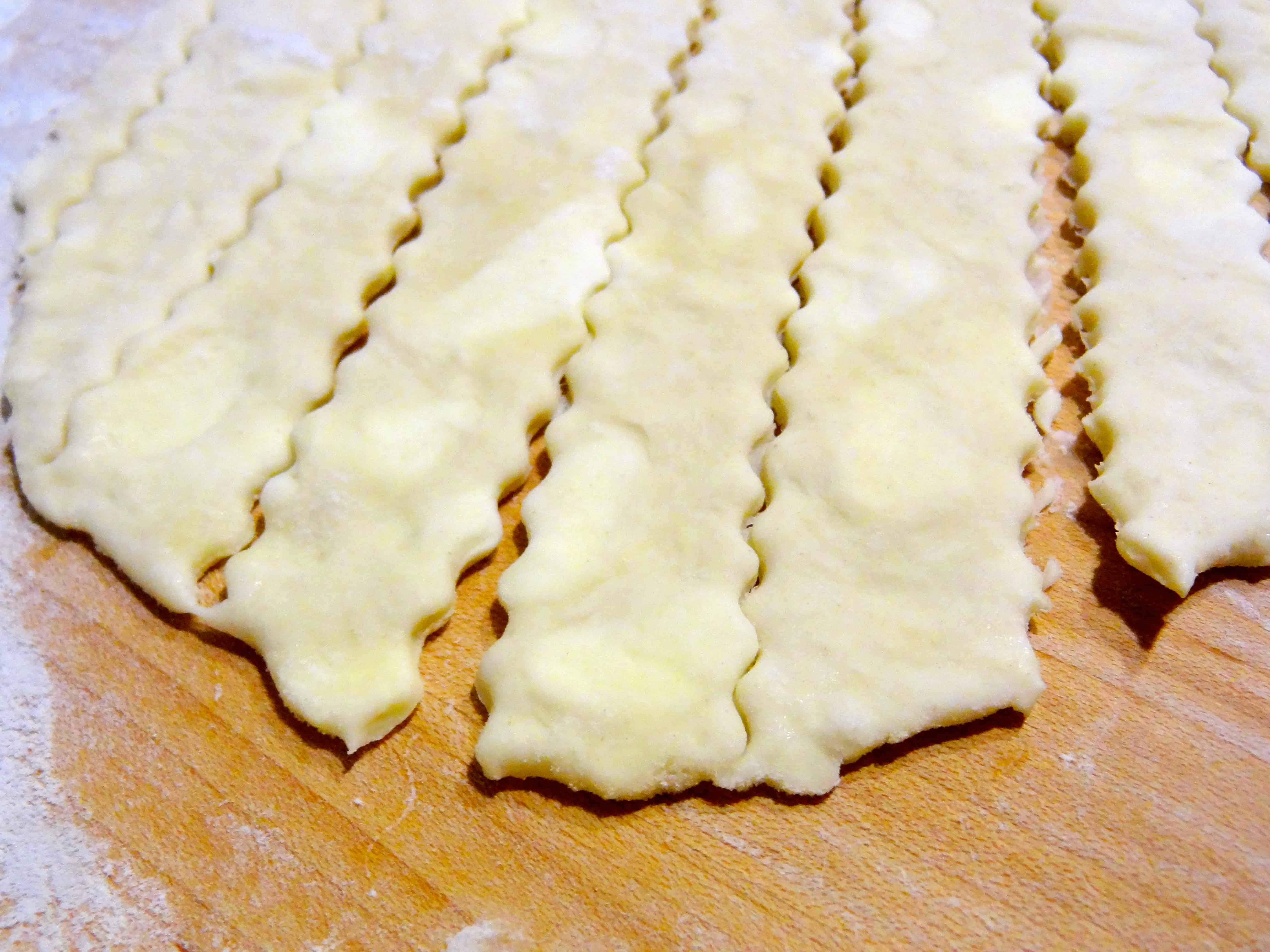
To make a lattice-top pie, use a pastry wheel, pizza wheel, or sharp knife to cut the pie dough into strips from ½- to 1-inch wide. Place every other strip on top of the peaches in one direction, spacing them evenly. Gently fold every *other* strip back on itself halfway, taking care to avoid sticking. Place the longest remaining strip on top of the laid-out strips in the other direction at the widest point of the pie, then fold the other strips back down on top of it. Repeat this process with each of the other strips (so that the strips alternate at each intersecting point to create a “woven” look), until a full lattice is formed or you run out of strips– whichever comes first.
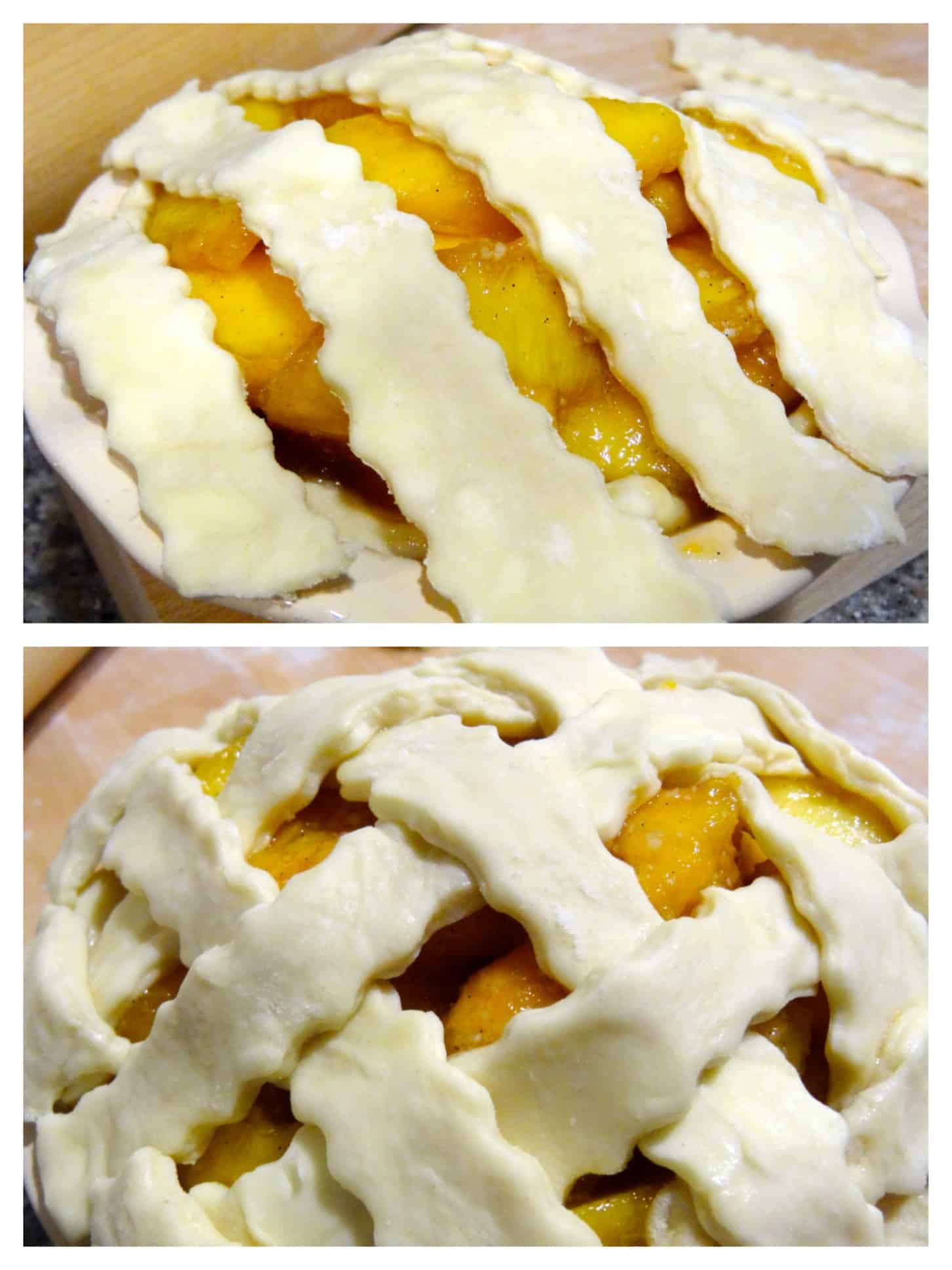
I envisioned making a tight lattice like Smitten Kitchen’s, but I ran out of dough strips, so I had to space them out a little farther than planned– no matter. Remember to work quickly (I can’t stress this enough), as these small strips will soften in no time in your hands. (I was so focused on my lattice that I forgot to take photos of the folded-back strips!)
Trim any overhanging lattice strips to the diameter of the pie plate rim; just the bottom crust will have that 1 inch of overhanging dough. I tend to have trouble rolling out dough big enough for a decent overhang (let alone in an even circle), so there wasn’t enough to fold over and crimp pretty edges; I’m sure yours will be lovely, and I shall continue to practice mine. Fold or roll that allegedly overhanging bottom crust over the lattice strips and crimp the dough between your thumb and fingers to make a fluted (or otherwise attractive) pattern all the way around the pie. Put the pie in the fridge to re-chill the dough before it goes in the oven.
If making mini pies like I did, repeat the above process for the second pie with the remaining half of the first dough round, and then make 2 more pies in the same way with the second dough round. (In other words, use half of a dough round for each mini pie.) I did a sort of “rotation”– when one pie was chilling in the freezer/fridge, I worked on the other pie, and vice-versa in stages. Working with the little pies is a bit of a juggling act, but they are just so cute– it’s like when you look in your baby’s eyes for the first time and fall instantly in love, forgetting the labor you’ve just gone through. (That’s kinda the same, right? Right?!… Clearly I don’t have children.)
The last step is applying the topping. If using vanilla bean sugar, mix it into your coarse or granulated sugar in a small bowl. I used coarse sugar, as I like the sparkly look and the crunch that it gives to the pie top. Brush the lattice strips with heavy cream, milk, or water. (I used cream, because let’s be honest– when given the choice, I will generally go with the most decadent option.) Sprinkle the vanilla sugar over the cream as liberally as you wish.
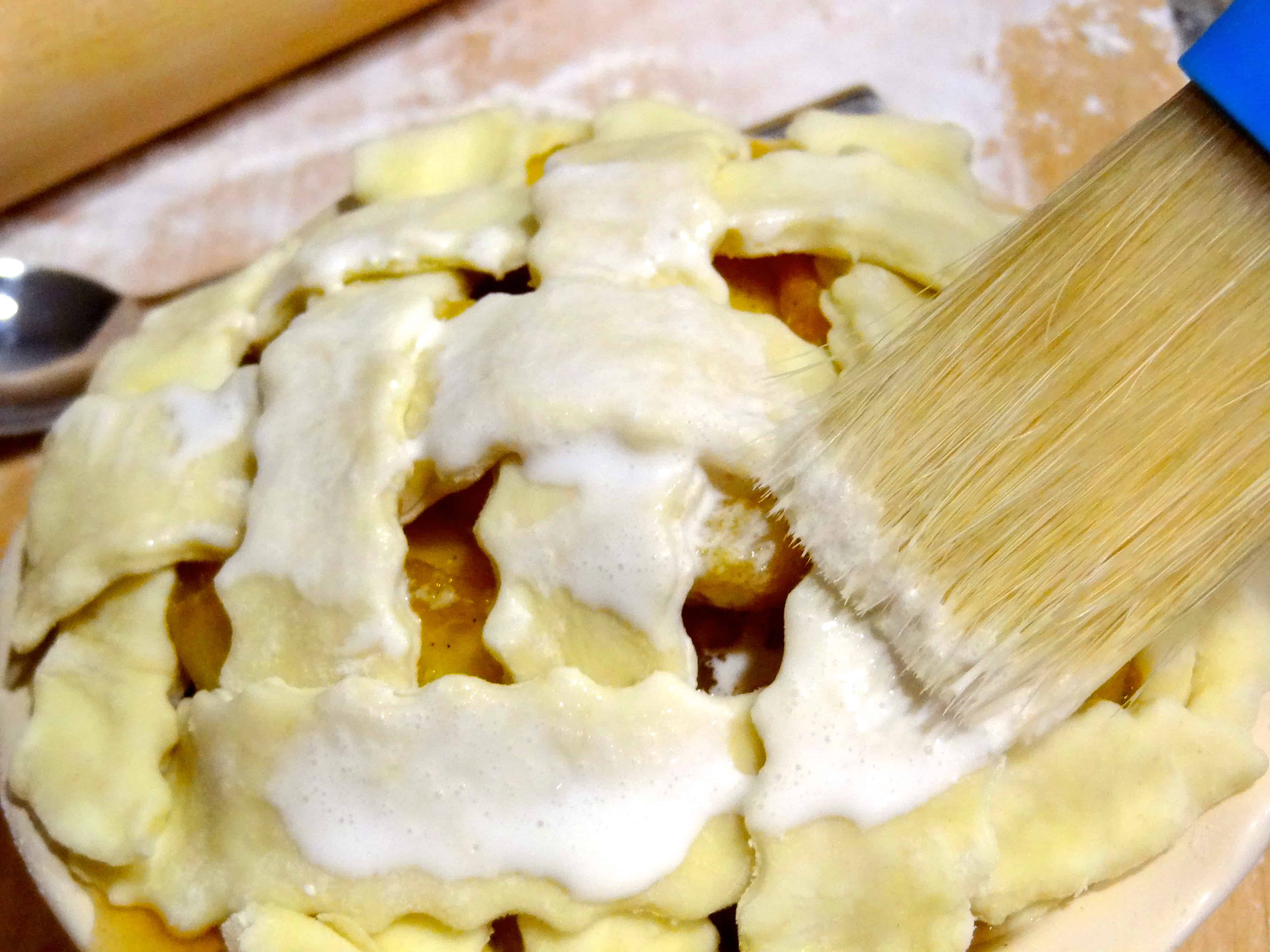
Finally… it’s time to bake. Place your full-sized or mini pie(s) on a baking sheet to catch the bubbling, peachy juices. (I may have poured too much of the accumulated juices from the filling into my pies, as they were veritable fountains in the oven.)
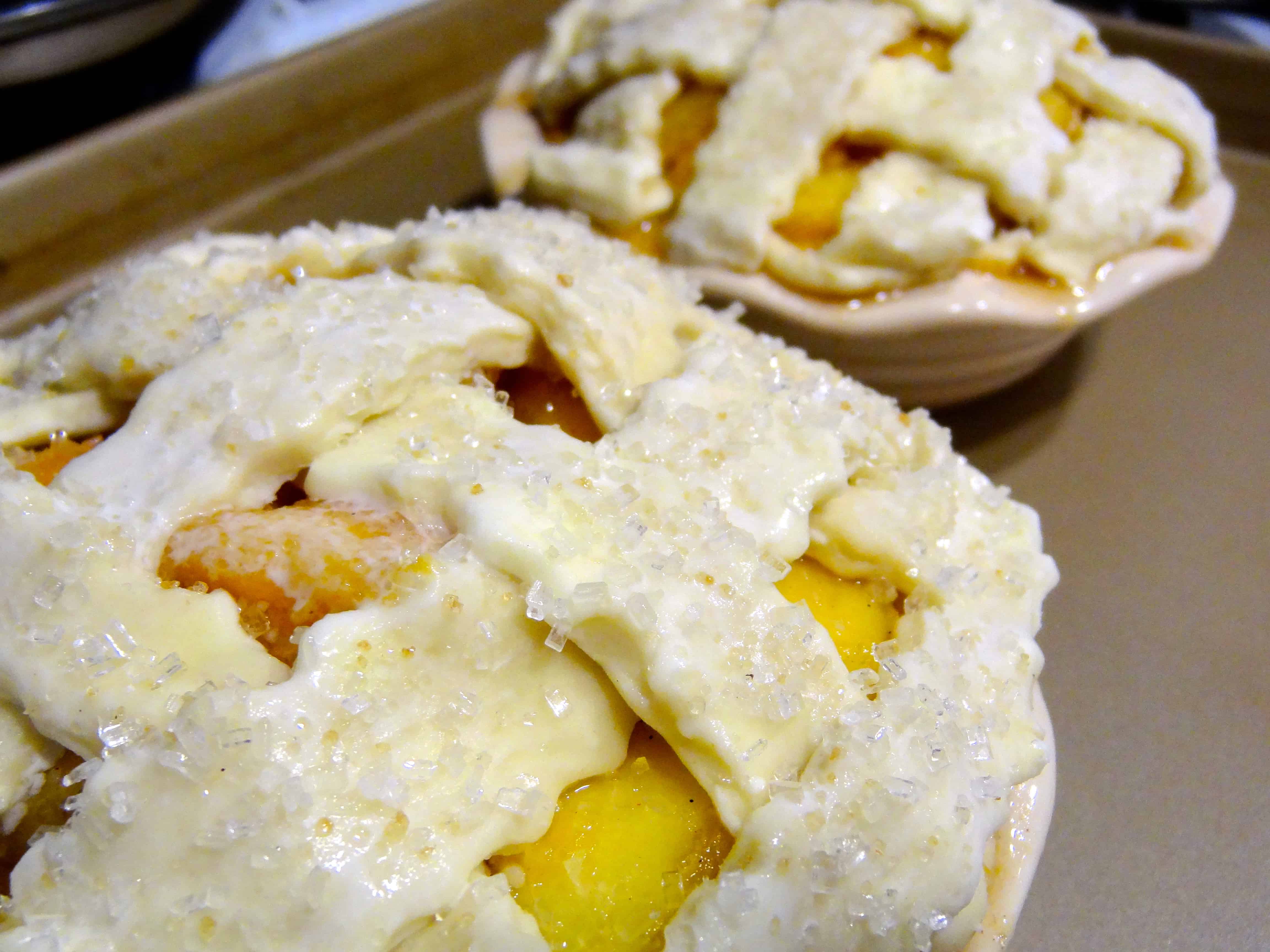
Bake a full-size pie for 20 minutes at 425°F (15 minutes for mini pies), until the crust has set and is starting to brown. Reduce the oven temperature to 375°F and bake a single pie for an additional 30-40 minutes, or 25-30 minutes for minis (mine baked in 28), until the peaches are bubbling all over and the crust is a handsome golden brown, puffed and flaky. If the top crust gets too dark during baking, cover it loosely with aluminum foil for the rest of the baking time to prevent burning.
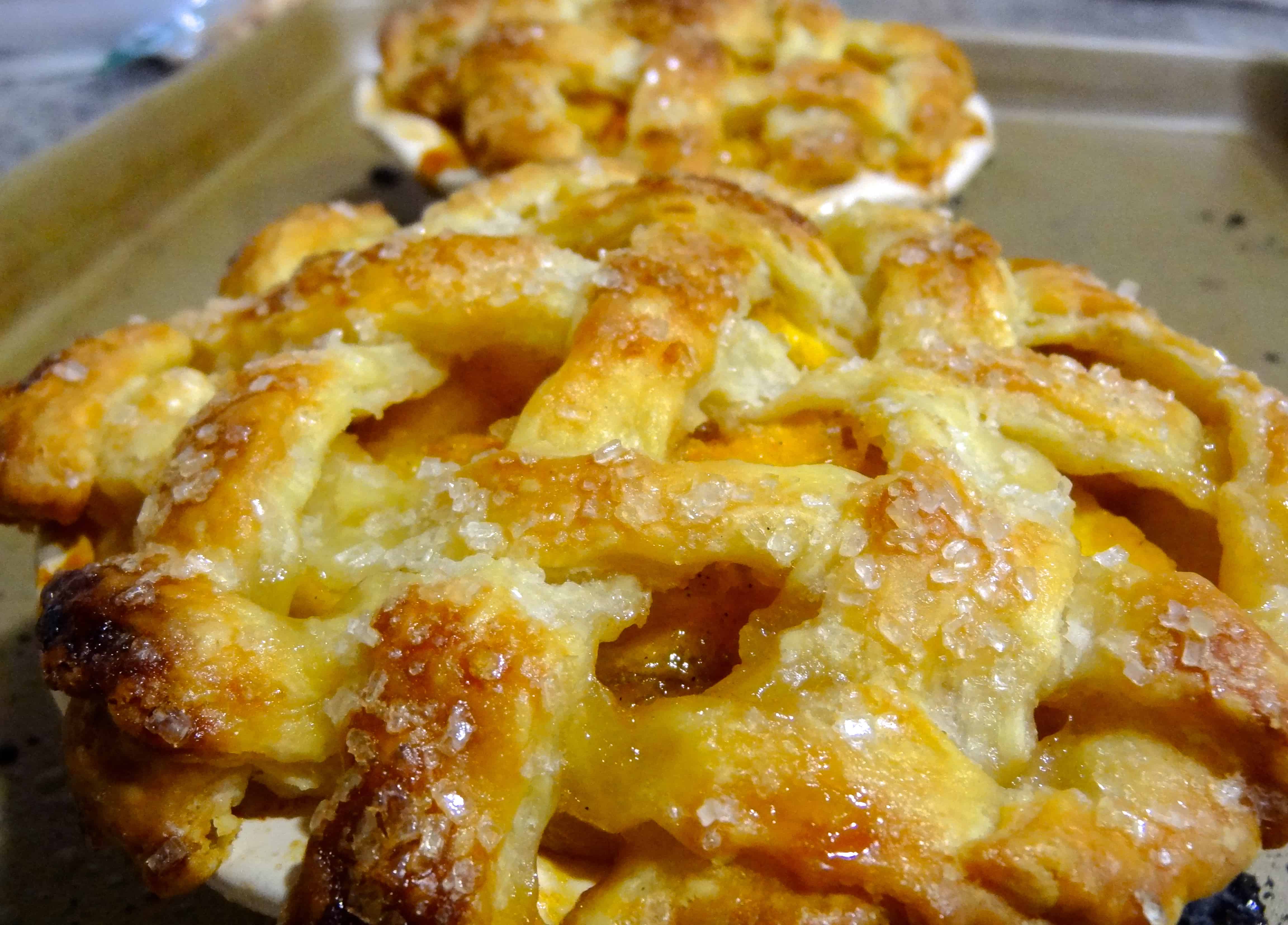
Let the pie cool for at least 3 hours on a wire cooling rack before serving; the filling will firm up once it has cooled. (If runny pie filling is not vexing for you, you are certainly welcome to eat it hot.) Now, many people will argue that this pie should not, under any circumstances, be eaten without a generous scoop of vanilla ice cream on top; while I agree in theory, I have to admit that it didn’t occur to me to pick up ice cream the night before surgery (I know, what?!), so I was not able to carry out the final component of this dessert mission. If ice cream purchasing is within your power, please feel free to top your pie (or better yet, make your own ice cream). The pie can be stored at room temperature or in the fridge for a couple of days. Go forth and eat summer pie! 🙂
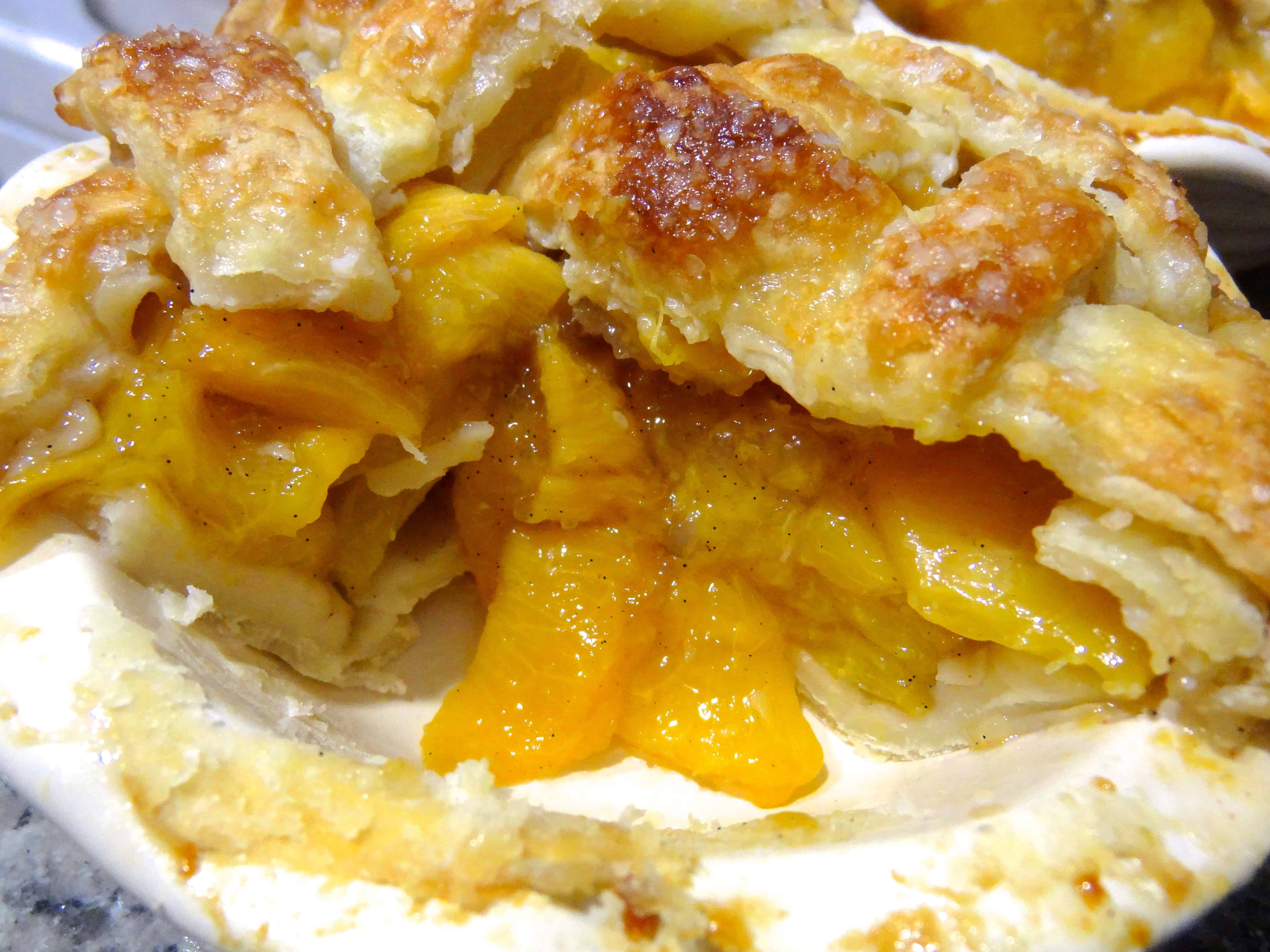

© Dafna Adler & Stellina Sweets, 2013.




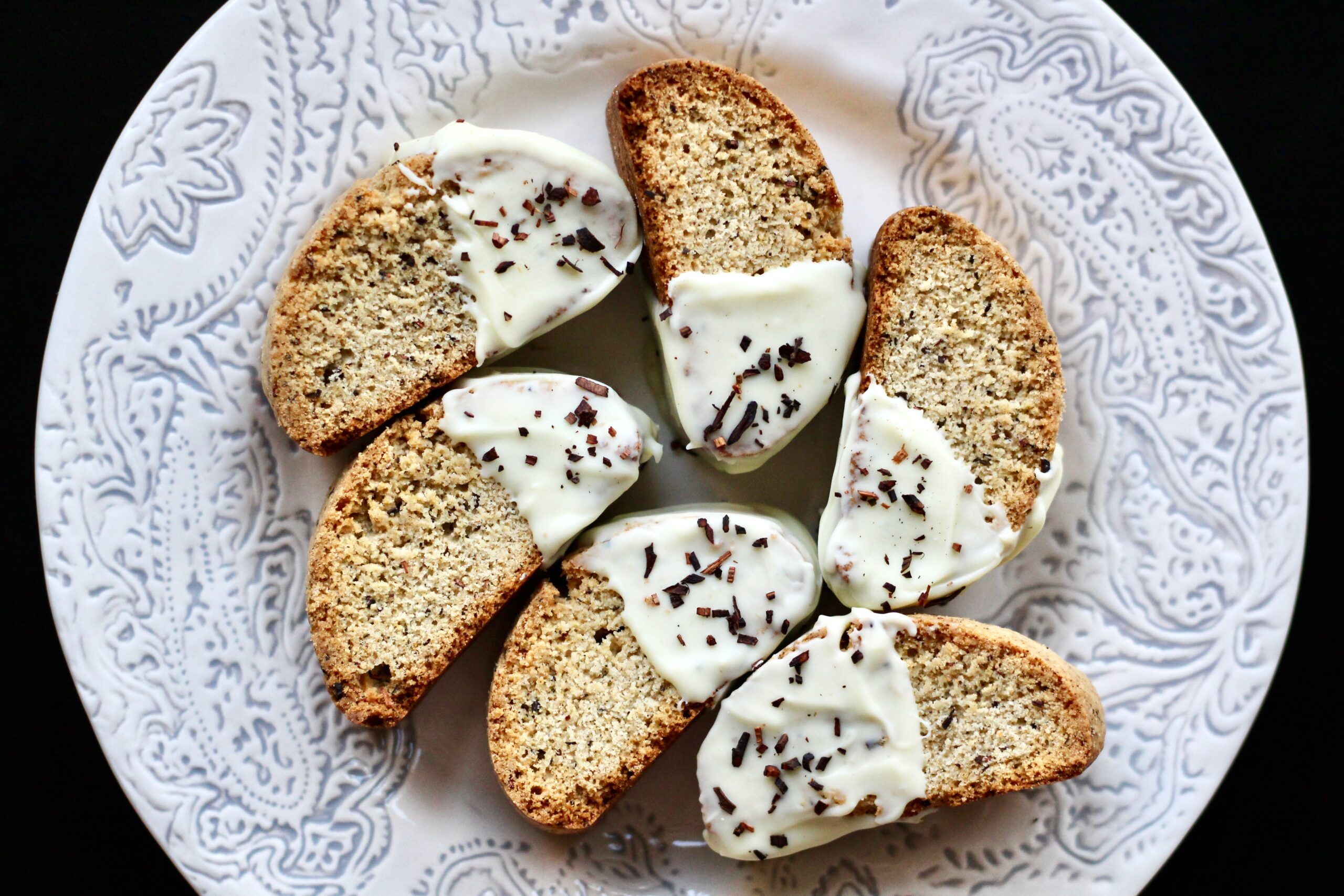
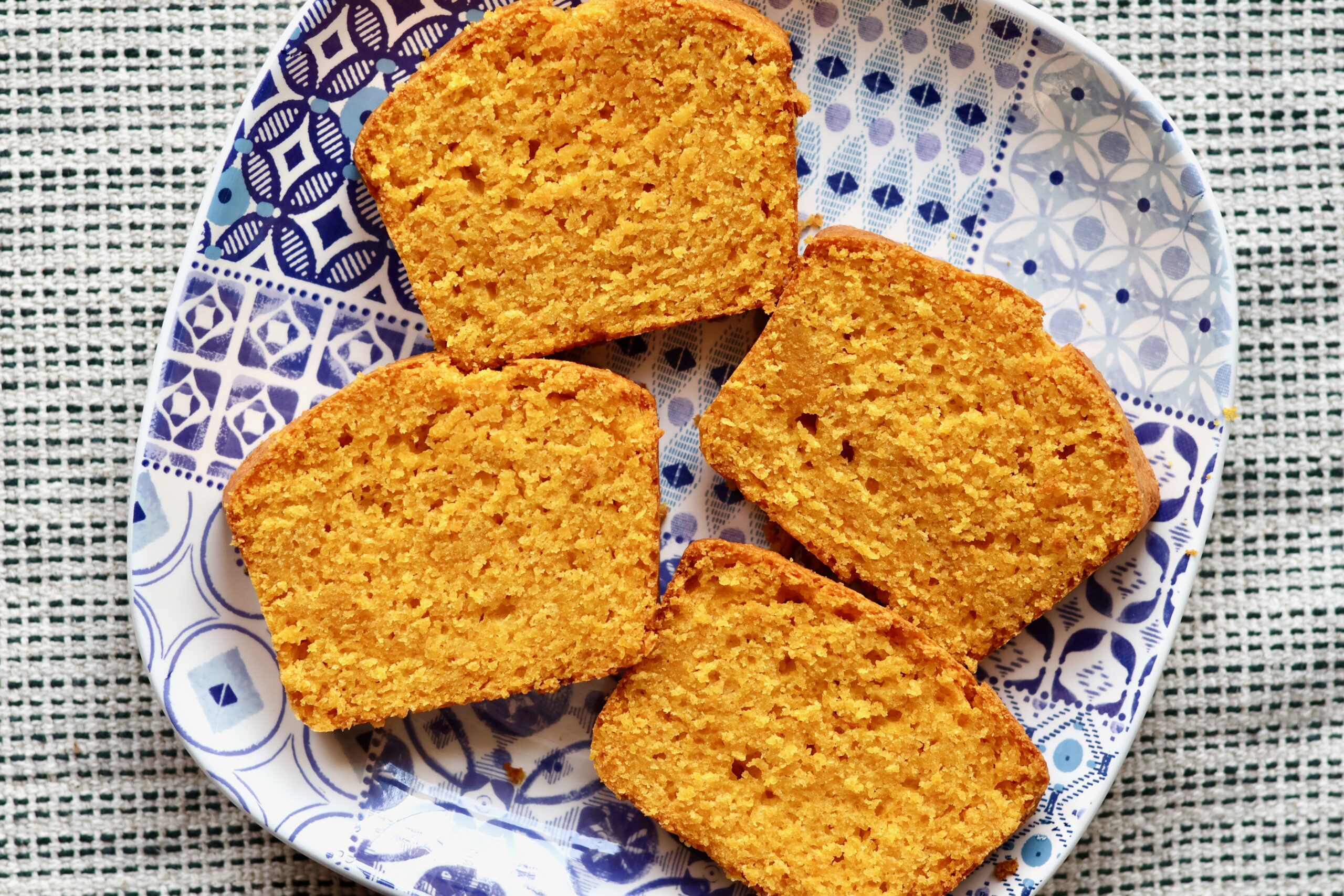
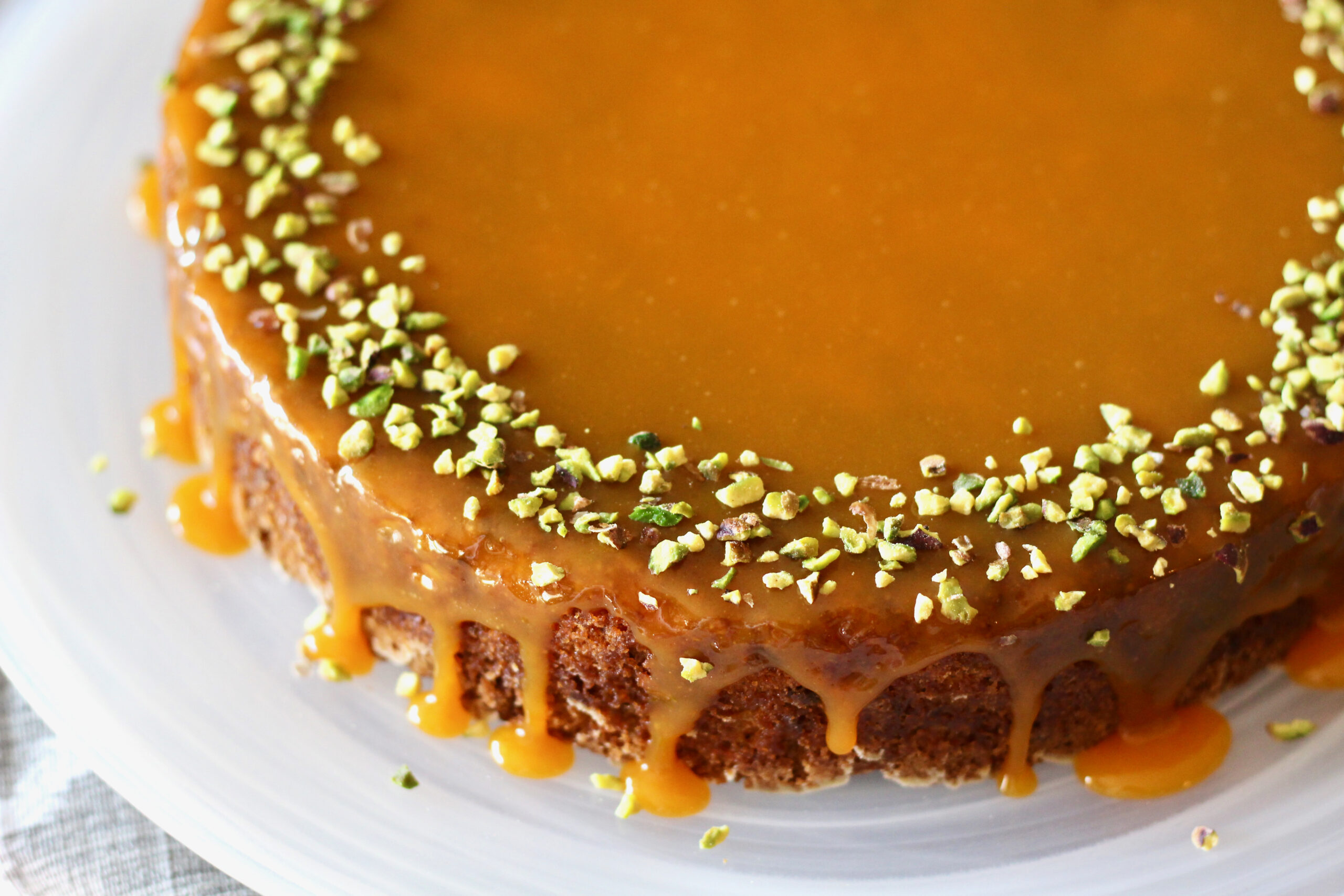
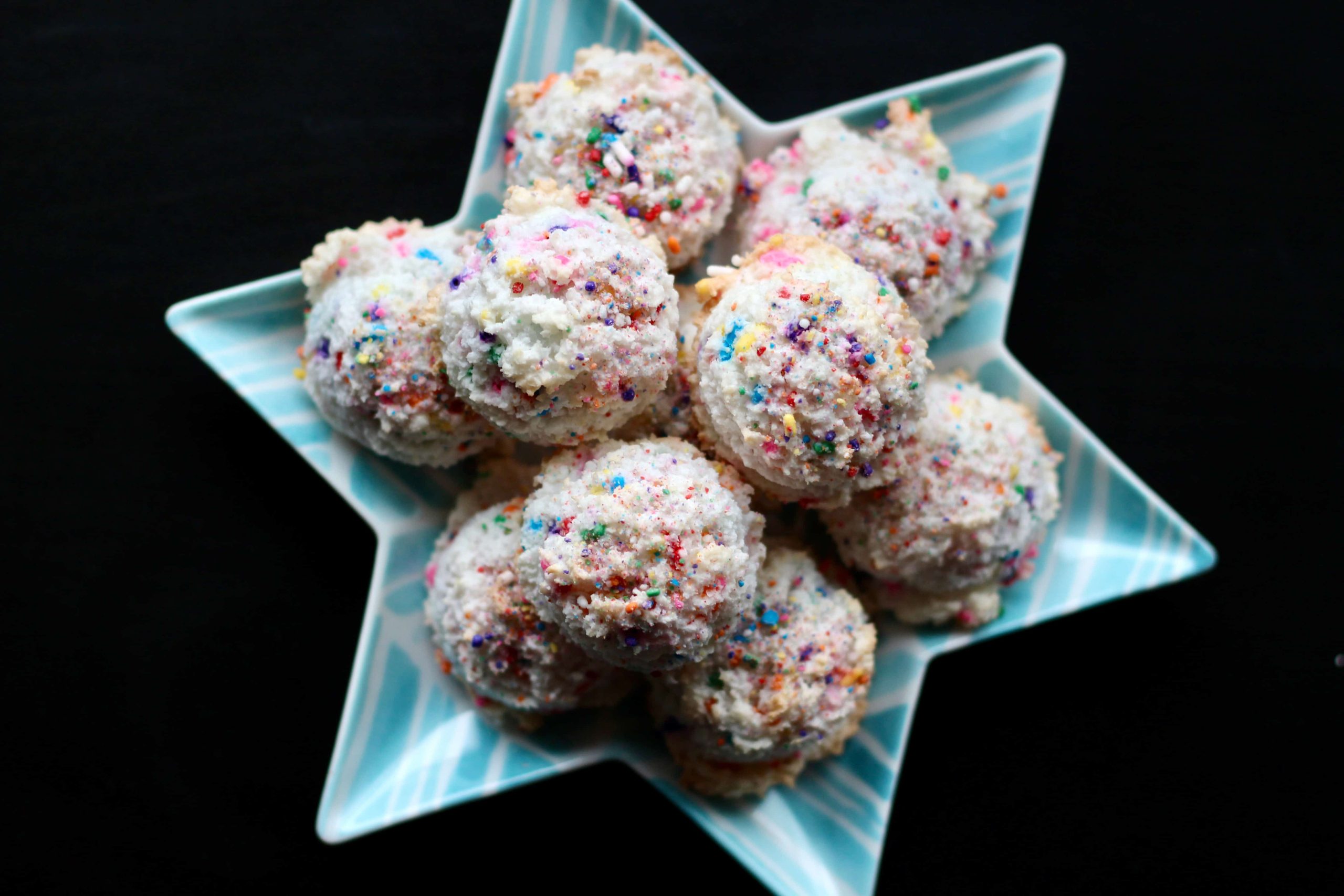
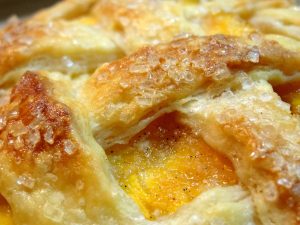

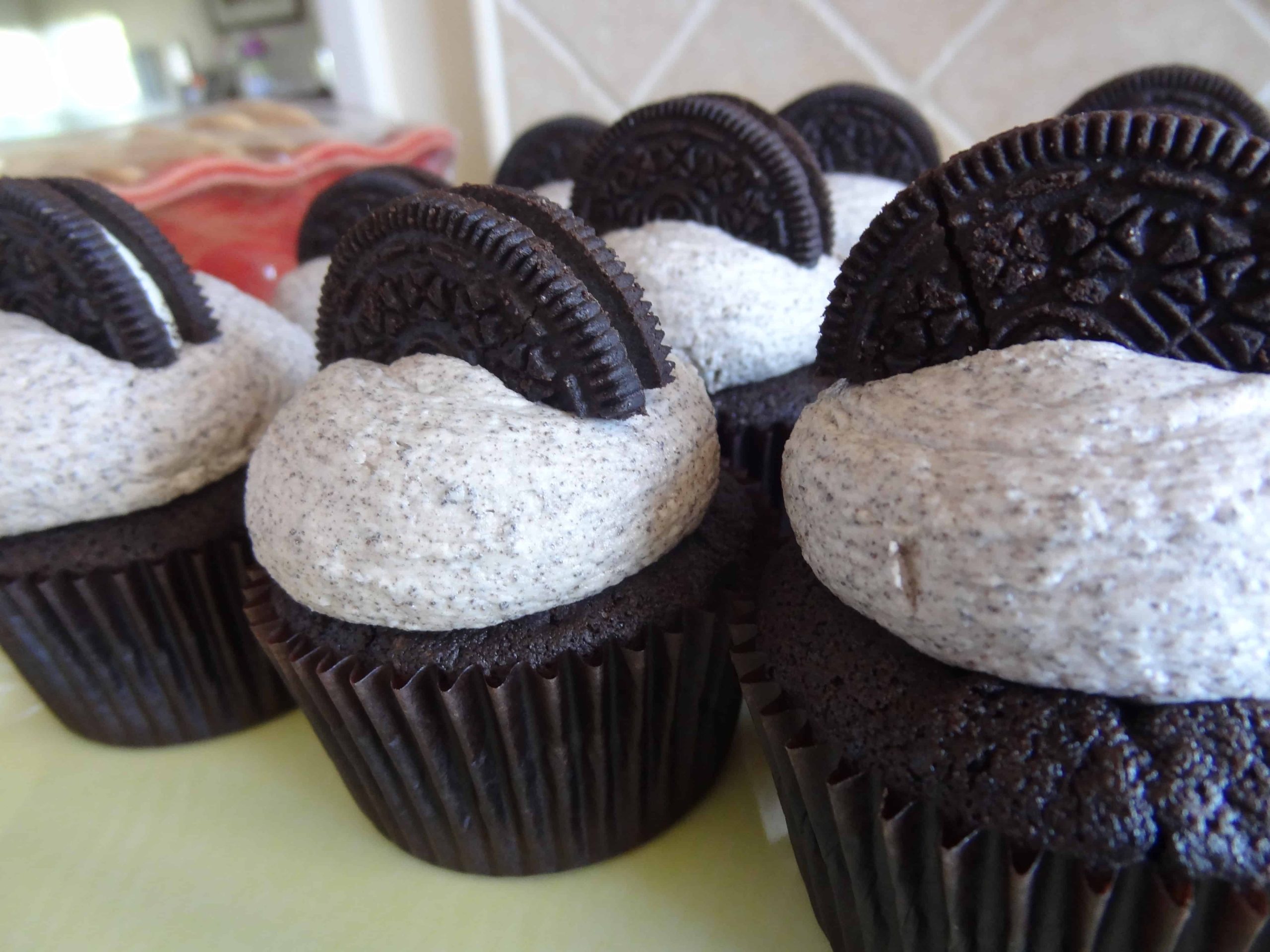

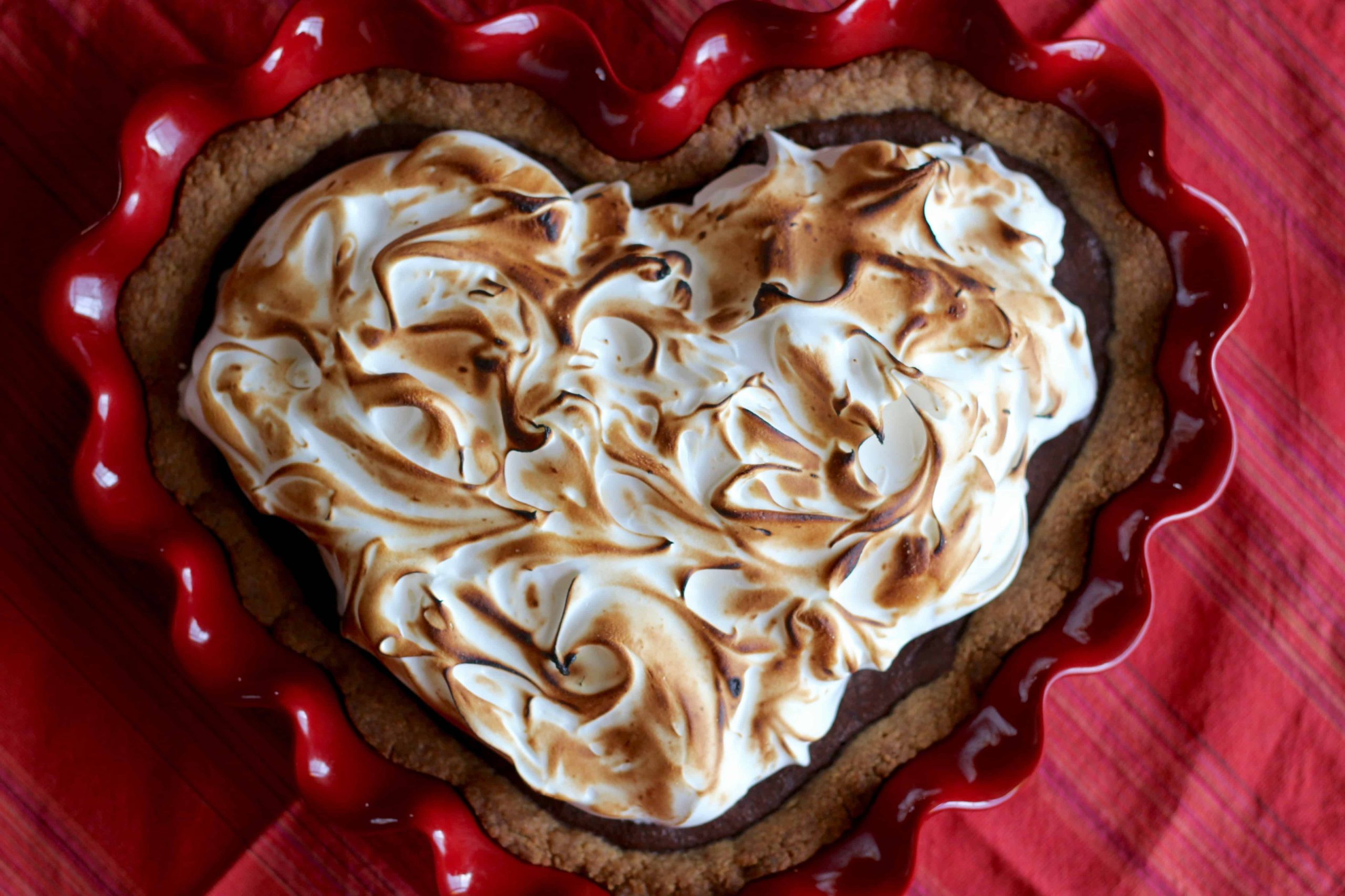
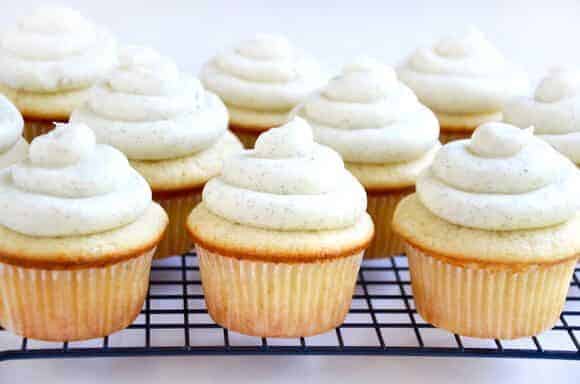
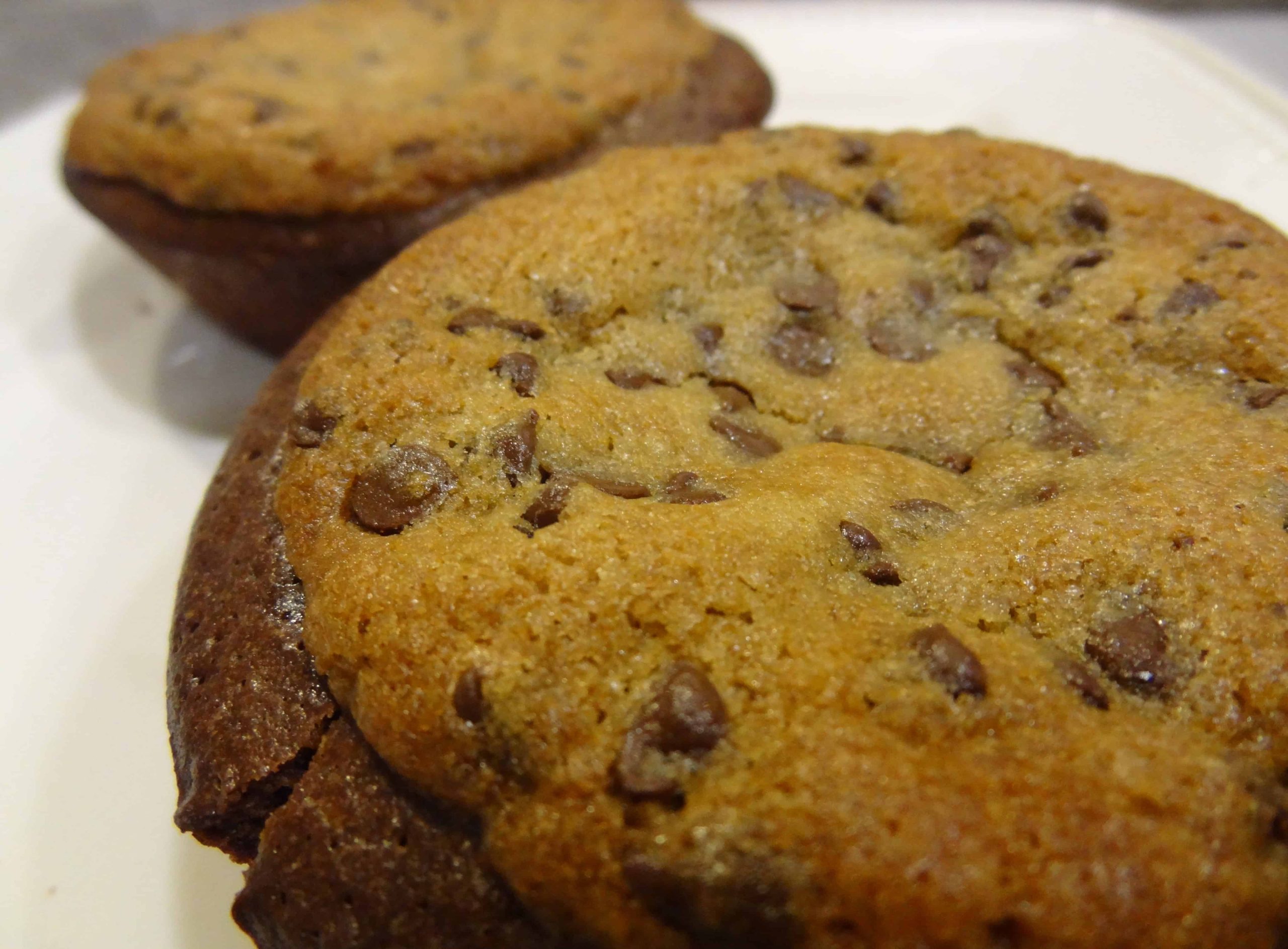
One Response